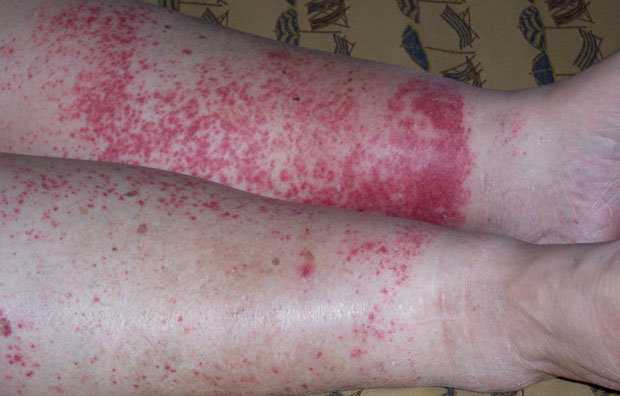MKSAP Quiz: Lower extremity edema, rash
A 31-year-old woman is evaluated for lower extremity edema, a rash over both legs, and fatigue that have worsened during the past 3 months. She has no other medical problems and takes no medications. The patient was born in Egypt and moved to the United States at 20 years of age.

On physical examination, the patient is afebrile, and blood pressure is 147/96 mm Hg. There is 1-mm pitting edema through the mid-shins bilaterally.
The rash is shown.
Laboratory studies:
| Albumin | 3.9 g/dL (39 g/L) |
| C3 | 58 mg/dL (580 mg/L) |
| C4 | 5.0 mg/dL (50 mg/L) |
| Creatinine | 2.6 mg/dL (229.8 µmol/L) |
| Cryoglobulins | Positive |
| Rheumatoid factor | Positive |
| Urinalysis | 3+ blood; 3+ protein; erythrocytes and rare erythrocyte casts |
| Urine protein-creatinine ratio | 2100 mg/g |
A kidney biopsy is scheduled.
Which of the following viral studies will support the most likely diagnosis?
A. Fourth-generation HIV testing
B. Hepatitis A virus antibody testing
C. Hepatitis B virus surface antigen and surface antibody testing
D. Hepatitis C virus antibody testing
Answer and critique
The correct answer is D. Hepatitis C virus antibody testing. This content is available to MKSAP 19 subscribers as Question 81 in the Nephrology section.
The most appropriate viral study to perform is hepatitis C virus (HCV) antibody testing (Option D), and if positive, viral load measurement and genotyping. This patient's clinical presentation (purpuric rash) and laboratory results (low complement levels, positive rheumatoid factor, and positive cryoglobulins) support the diagnosis of cryoglobulinemic glomerulonephritis; biopsy is most likely to reveal membranoproliferative glomerulonephritis (MPGN). Cryoglobulinemia denotes the presence of clonal or polyclonal immunoglobulins that precipitate in the serum at temperatures <37.0 °C (98.6 °F) and dissolve with rewarming. Cryoglobulinemia is classified as type I, II, or III based on the composition of the cryoglobulins. Type I cryoglobulinemia involves a monoclonal immunoglobulin, usually IgM, and is associated with plasma cell dyscrasias. Types II and III are called mixed cryoglobulinemia; they are composed of a mixture of polyclonal IgG and monoclonal or polyclonal IgM. Mixed cryoglobulinemia is usually seen in association with infections such as HCV, connective disorders, and, rarely, lymphoproliferative disorders. Cutaneous symptoms (palpable purpura, Raynaud phenomenon, ulcers, necrosis, and livedo reticularis) predominate in 70% to 90% of patients with mixed cryoglobulinemia. Peripheral neuropathy (60%), arthritis (40%), and glomerulonephritis (40%) are common. An estimated 2% to 3% of the world population has HCV, but higher prevalence rates are seen in certain geographic locations, such as Egypt, where >10% of the population has HCV. Treatment of cryoglobulinemic glomerulonephritis due to HCV infection is aimed at eradication of the virus using direct-acting antiviral drugs with or without concomitant immunosuppression based on severity of disease.
Hepatitis A virus (Option B) infection has not been associated with specific glomerular lesions. Although hepatitis B virus (HBV) infection and HIV infection (Options A, C) have been linked to glomerular diseases, these have classically been nephrotic syndromes, specifically membranous nephropathy with HBV and focal segmental glomerulosclerosis with HIV. This patient has a nephritic syndrome not compatible with HBV- or HIV-associated glomerular diseases.
Key Points
- Hepatitis C virus infection is associated with cryoglobulinemic glomerulonephritis.
- Treatment of hepatitis C–associated cryoglobulinemic glomerulonephritis is direct-acting antiviral drugs.



